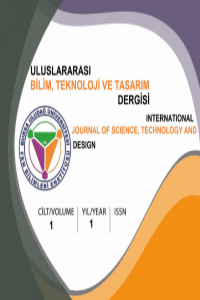Investigation of Size Exclusion Chromatography (SEC) Column Performance for Detection of Microplastics in Aquatic Environment
Microplastics, Size Exclusion Chromatography, Ultra-hydrogel Columns
___
- Barnes, D. K. A., Galgani, F., Thompson, R. C., & Barlaz, M. (2009). Accumulation and fragmentation of plastic debris in global environments. Philosophical Transactions of the Royal Society B: Biological Sciences, 364(1526), 1985–1998. https://doi.org/10.1098/rstb.2008.0205
- Biver, T., Bianchi, S., Carosi, M. R., Ceccarini, A., Corti, A., Manco, E., & Castelvetro, V. (2018). Selective determination of poly(styrene) and polyolefin microplastics in sandy beach sediments by gel permeation chromatography coupled with fluorescence detection. Marine Pollution Bulletin, 136(August), 269–275. https://doi.org/10.1016/j.marpolbul.2018.09.024
- Browne, M. A., Galloway, T., & Thompson, R. (2007). Microplastic-an emerging contaminant of potential concern? Integrated Environmental Assessment and Management, 3(4), 559–561. https://doi.org/10.1002/ieam.5630030412
- Carpenter, E. J., Anderson, S. J., Harvey, G. R., Miklas, H. P., & Peck, B. B. (1972). Polystyrene Spherules in Coastal Waters. Science, 178(4062), 749–750. https://doi.org/10.1126/science.178.4062.749
- Cole, M., Lindeque, P., Halsband, C., & Galloway, T. S. (2011). Microplastics as contaminants in the marine environment: A review. Marine Pollution Bulletin, 62(12), 2588–2597. https://doi.org/10.1016/j.marpolbul.2011.09.025
- Costa, M. F., Ivar Do Sul, J. A., Silva-Cavalcanti, J. S., Araújo, M. C. B., Spengler, Â., & Tourinho, P. S. (2010). On the importance of size of plastic fragments and pellets on the strandline: A snapshot of a Brazilian beach. Environmental Monitoring and Assessment, 168(1–4), 299–304. https://doi.org/10.1007/s10661-009-1113-4
- Frias, J. P. G. L., & Nash, R. (2019). Microplastics: Finding a consensus on the definition. Marine Pollution Bulletin, 138(September 2018), 145–147. https://doi.org/10.1016/j.marpolbul.2018.11.022
- Gregory, M. R. (1996). Plastic ‘scrubbers’ in hand cleansers: a further (and minor) source for marine pollution identified. Marine Pollution Bulletin, 32(12), 867–871. https://doi.org/10.1016/S0025-326X(96)00047-1
- Harrison, J. P., Ojeda, J. J., & Romero-González, M. E. (2012). The applicability of reflectance micro-Fourier-transform infrared spectroscopy for the detection of synthetic microplastics in marine sediments. Science of the Total Environment, 416, 455–463. https://doi.org/10.1016/j.scitotenv.2011.11.078
- Hintersteiner, I., Himmelsbach, M., & Buchberger, W. W. (2015). Characterization and quantitation of polyolefin microplastics in personal-care products using high-temperature gel-permeation chromatography. Analytical and Bioanalytical Chemistry, 407(4), 1253–1259. https://doi.org/10.1007/s00216-014-8318-2
- Keller, R. A., & Giddings, J. C. (2022). Chromatography. Encyclopedia Britannica. https://www.britannica.com/science/chromatography
- Kirstein, I. V., Hensel, F., Gomiero, A., Iordachescu, L., Vianello, A., Wittgren, H. B., & Vollertsen, J. (2021). Drinking plastics? – Quantification and qualification of microplastics in drinking water distribution systems by μFTIR and Py-GCMS. Water Research, 188, 116519. https://doi.org/10.1016/j.watres.2020.116519
- Laborda, F., Trujillo, C., & Lobinski, R. (2021). Analysis of microplastics in consumer products by single particle-inductively coupled plasma mass spectrometry using the carbon-13 isotope. Talanta, 221(July 2020), 121486. https://doi.org/10.1016/j.talanta.2020.121486
- Moore, C. J. (2008). Synthetic polymers in the marine environment: A rapidly increasing, long-term threat. Environmental Research, 108(2), 131–139. https://doi.org/10.1016/j.envres.2008.07.025
- Patel, M. M., Goyal, B. R., Bhadada, S. V, Bhatt, J. S., & Amin, A. F. (2009). Getting into the Brain. CNS Drugs, 23(1), 35–58. https://doi.org/10.2165/0023210-200923010-00003
- Thompson, R. C., Olsen, Y., Mitchell, R. P., Davis, A., Rowland, S. J., John, A. W. G., McGonigle, D., & Russell, A. E. (2004). Lost at Sea: Where Is All the Plastic? Science, 304(5672), 838–838. https://doi.org/10.1126/science.1094559
- WHO. (2019). Microplastics in drinking-water: World Health Organization. https://apps.who.int/iris/rest/bitstreams/1243269/retrieve
- Zitko, V., & Hanlon, M. (1991). Another source of pollution by plastics: Skin cleaners with plastic scrubbers. Marine Pollution Bulletin, 22(1), 41–42. https://doi.org/10.1016/0025-326X(91)90444-W
- Başlangıç: 2020
- Yayıncı: Bursa Uludağ Üniversitesi
Metal Malzeme Yüzeylerine Atmosferik Basınçlı Plazma Uygulamasının Yapıştırma Bağlarına Etkisi
Öyküm KANBİR, Emel TAŞYAKAN, Kadir ÇAVDAR
MEDİKAL TEKSTİLLERDE KULLANILMAK ÜZERE ÖRME VE DOKUMA KUMAŞ GELİŞTİRİLMESİ
Mehmet KERTMEN, Hakan KARAGÖL, Halil İbrahim OLUCAK, Elif Aylin PEKTAŞ, Aybüke ŞEN, Ahmet Recep HELVACI
Batarya Elektrikli Araçlarda Şanzıman Tipleri Üzerine Derleme
Roles of Plant and Fungal Lectins in Cancer Diagnosis and Treatment: A Scoping Review
